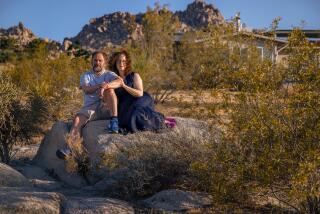The Heart Revealed--Via Myth and Memoir
- Share via
It was an editor’s idea, apparently. Gail Godwin, having “just reread Conrad’s two novellas ‘Heart of Darkness’ and ‘The Secret Sharer,’ ” was thinking of writing a novel about “a woman’s journey into the heart of darkness where she would have to confront her shadow. Sort of a modern version of what the ancient Sumerian goddess Inanna, Queen of Heaven, undertook when she set her heart on the Great Below and descended into the underworld to visit her dark sister, Queen Ereshkigal.”
Then the editor called with a “delicious, rather quirky idea--a book about the heart. Not a medical book, but the ways we’ve imagined the heart through time in myth and art and popular culture and what these images tell us about the human condition, then and now. It would be informative, but not scholarly. More of a lush, writerly, intimate book with a narrative arc.”
Godwin agreed that she would enjoy reading such a book--though, occupied with her new novel, she couldn’t be the one to write it. Then she came up with so many ideas about what kind of book it should be and what it should contain--including “personal anecdotes . . . written from the writer’s heart”--that both she and the editor realized she was hooked.
The result is “Heart,” the first nonfiction work for Godwin, whose novels include “Glass People,” “The Odd Woman,” “Violet Clay,” “A Southern Family” and “Evensong.” It’s a readable and entertaining survey that lives up to the vision Godwin and her editor had for it, though we also can’t help wishing he had kept his mouth shut and let her write more fiction.
In the first half of the book, Godwin examines Sumerian, Egyptian, Hebrew, Hindu, Buddhist, Chinese, Japanese, Greek, Christian and Muslim notions of the heart. She reminds us that In-anna’s journey to the underworld preceded Persephone’s by many centuries, that the Koran is surprisingly woman-friendly, and that the Greeks--as Robert Pirsig pointed out in “Zen and the Art of Motorcycle Maintenance”--began the classic-romantic split of head from heart, cool logic from warm emotion, that has cleft our inner landscapes ever since.
In the second half, Godwin examines heart themes in literature--Conrad, of course, the poetry of Rainer Rilke, Yeats and George Herbert, the memoirs of St. Theresa of Avila, Pascal’s “Pensees,” Shakespeare’s sonnets, Dickens’ “Hard Times,” Elizabeth Bowen’s “The Death of the Heart,” the heart-absence of Gilbert Osmond in Henry James’ “Portrait of a Lady” and C.S. Lewis’ late-life discovery of his own heart in “A Grief Observed.”
The “narrative arc” of the book is twofold. It consists, on one hand, of Godwin’s efforts to grow in “heart-consciousness” through events in her own life, such as the fatal double shooting of her brother and his girlfriend, fictionalized in her novel “A Southern Family,” and, on the other, of her efforts to extract from history and literature some signs of hope that the head-heart split is beginning to heal.
Discussing Hindu beliefs, for instance, she notes that some psychologists “see a correspondence” between current Western consciousness and the third chakra, the solar plexus, whose “purpose is power, will and self-definition. It is the locus of vitality, but also of aggression.” But they also see “evolutionary spurts toward the next level . . . the heart chakra.”
Godwin finds “evolutionary spurts” in sources as diverse as the writings of Pierre Teilhard de Chardin, the paintings and personality of Paul Klee and the extraordinary parties thrown by a North Carolina doctor for “her overworked and underplayful friends.”
She ends on a hopeful note: Writing “Heart,” she says, has given her--as reading it with any attention should give us--a better idea of what it means to be human. Now for that novel.
More to Read
Sign up for our Book Club newsletter
Get the latest news, events and more from the Los Angeles Times Book Club, and help us get L.A. reading and talking.
You may occasionally receive promotional content from the Los Angeles Times.










